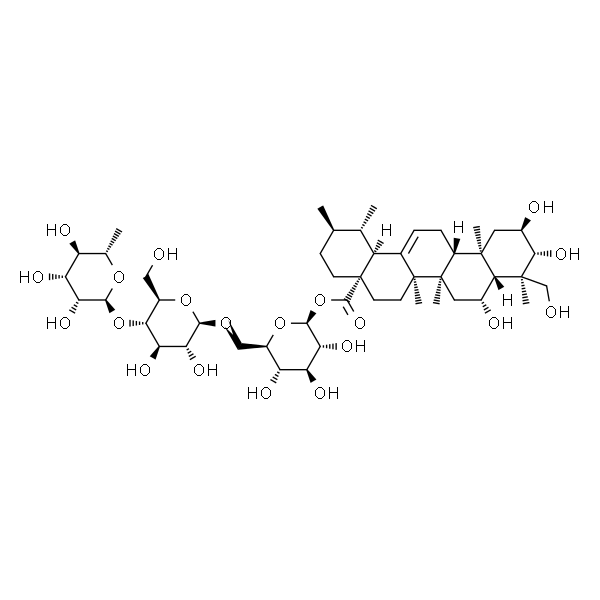Madecassoside;羟基积雪草苷
货号:
IM0480
品牌:
Jinpan

暂无详情
产品简介
| MDL | MFCD00017380 |
| EC | EINECS 252-076-1 |
| 别名 | 羟基积雪草甙;AsiaticosideA |
| 英文名称 | Madecassoside |
| CAS | 34540-22-2 |
| 分子式 | C48H78O20 |
| 分子量 | 975.12 |
| 纯度 | HPLC≥98% |
| 单位 | 瓶 |
| 生物活性 | Madecassoside has potent anti-pulmonary fibrosis (PF) effects.Madecassoside increases the activity of PPAR-γ, which subsequently increases HGF expression in colonic epithelial cells. Madecassoside could protect HUVECs from oxidative injury.[1-2] |
| In Vitro | Madecassoside (10, 30, 100 μmol/L) could reverse morphological changes, elevate cell viability, increase glutathione levels, and decrease lactate dehydrogenase andmalondialdehyde levels caused by H2O2 in a concentration-dependent manner. It attenuates apoptosis, preventing the activation of caspase-3 and the loss of mitochondria membrane potential, as well as the phosphorylation of p38 mitogen activated protein kinase (MAPK) in HUVECs. Hence, Madecassoside could protect HUVECs against lipid peroxidation and apoptosis caused by H2O2[1]. |
| In Vivo | The pharmacokinetic study of madecassoside in rats indicates that the maximum plasma concentration is 303.75 ± 28.53 ng/mL after single oral administration (100 mg/kg). Madecassoside, administered orally for 20 days at doses of 6, 12, and 24 mg/kg, effectively facilitates burn wound healing in mice. It could reduce the burn wound area, leading to a better healing pattern with almost complete wound closure in mice[1]. Madecassoside has potent anti-pulmonary fibrosis (PF) effects when administered p.o., despite having extremely low oral bioavailability. The potent anti-PF effects induced by p.o. madecassoside in mice are not mediated by its metabolites or itself after absorption into blood. i.p. madecassoside has no anti-PF effect. Madecassoside increases the activity of PPAR-γ, which subsequently increases HGF expression in colonic epithelial cells. HGF then enters into the circulation and lung tissue to exert an anti-PF effect[2]. |
| SMILES | O=C(C1(CCC(C)C2C)C2C3=CCC4C(C)(CC(O)C5C4(CC(O)C(O)C5(C)CO)C)C3(C)CC1)OC(C(C(O)C6O)O)OC6COC(C(C(O)C7OC(OC(C)C(O)C8O)C8O)O)OC7CO |
| 靶点 | Others |
| 动物实验 | HUVECs are harvested using 0.25% trypsin solution and inoculated in 96-well plates at a density of 1 × 104 cells/well. Cells are treated with H2O2 (500 μmol/L) and/or a variety of concentrations of madecassoside (10, 30, 100 μmol/L). The culture plate is then placed in 5% (v/v) CO2 at 37?C for 8 h. At the end of incubation, 20 μL of MTT (5 mg/mL) is added to each well and the cells are incubated for another 4 h at 37?C with 5% CO2. The supernatants are then discarded, and 200 μL of DMSO is added to each well. The absorbance is read at 540 nm and cell viability is expressed as percentage of untreated cells.[1] |
| 细胞实验 | Animal Models: Female ICR mice, 6-8 weeks-old and weighing 22-26 g; Dosages: 40 mg/kg; Administration: p.o. or i.p.[2] |
| 数据来源文献 | [1] Bian D, et al. J Biochem Mol Toxicol. 2012, 26(10):399-406. [2] Xia Y, et al. Br J Pharmacol. 2016, 173(7):1219-35. |
| 规格 | 5mg 10mg 20mg |
Madecassoside是一个五环三萜。
